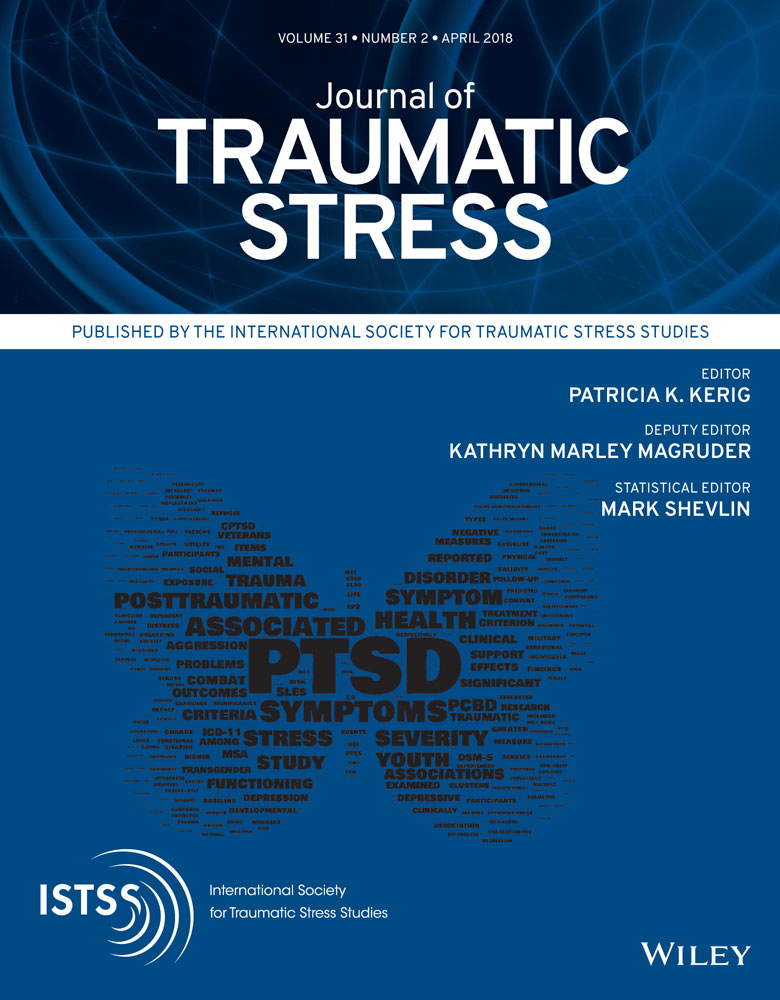The Effects of Trauma Type and Executive Dysfunction on Symptom Expression of Polyvictimized Youth in Residential Care
The authors wish to thank Melinda Baker for her help in preparing the manuscript.
Abstract
enRisk for traumatic sequelae is conveyed directly by risk factors (i.e., exposure to trauma), and via the disruption of developmental competencies. Exposure to caregiver trauma is an especially salient risk factor, as its early and pervasive nature is likely to undermine multiple facets of development, most notably the emergence of cognitive controls (i.e., executive function [EF]). Deficits in EF have been observed among youth exposed to multiple types of trauma and are associated with a range of functional impairments, posttraumatic stress symptoms (PTSS), and behavioral disorders; they represent a mechanism by which the negative impact of caregiver trauma is conveyed. This study included 672 youth in residential placement, and examined the associations between both caregiver and noncaregiver trauma, measured by the Trauma History Profile (THP); executive dysfunction, measured by the Behavioral Inventory of Executive Function (BRIEF); PTSS, measured by the UCLA Posttraumatic Stress Disorder (PTSD) Reaction Index (PTSD-RI); and externalizing and internalizing problems, measured by the Child Behavior Checklist (CBCL). A structural equation model demonstrated direct associations between caregiver trauma and PTSS, β = .15; noncaregiver trauma and externalizing problems, β = .14; gender and PTSS, β = .26, externalizing problems, β = .12, and internalizing problems, β = .26; and age and externalizing problems, β = −.11. We observed indirect effects via deficits in EF between caregiver trauma and PTSS, β = .04 and externalizing problems, β = .19. Results indicate for screening for executive dysfunction among trauma-impacted youth is needed, as it represents a critical therapeutic target.
Resumen
esSpanish Abstracts by the Asociación Chilena de Estrés Traumático (ACET)
Los efectos del tipo de trauma y disfunción ejecutiva en la expresión de síntomas de jóvenes polivictimizados bajo cuidado residencial
TIPO DE TRAUMA Y DISFUNCIÓN EJECUTIVA
El riesgo de secuelas traumáticas se transmite directamente por factores de riesgo (es decir, exposición a un trauma) y a través de la disrupción de las competencias de desarrollo. La exposición al trauma por parte del cuidador es un factor de riesgo especialmente saliente, dado que su naturaleza temprana y penetrante puede socavar múltiples facetas del desarrollo, más notoriamente la aparición de controles cognitivos (es decir, la función ejecutiva [FE en sus siglas en español]). Se han observado déficits en FE en jóvenes expuestos a múltiples tipos de trauma y están asociados con una variedad de deficiencias funcionales, síntomas de estrés postraumático (SEPT en su sigla en español) y trastornos de conducta; éstos representan un mecanismo por el cual el impacto negativo del trauma por parte del cuidador es transmitido. Este estudio incluyó a 672 jóvenes en internación residencial y examinó las asociaciones entre trauma por parte del cuidador y trauma no asociado al cuidador, medido con el Perfil del Historial de Trauma (THP en su sigla en inglés, Trauma History Profile); disfunción ejecutiva, medida con el Inventario de Comportamiento de la Función Ejecutiva (BRIEF en su sigla en inglés, Behavioral Inventory of Executive Function); síntomas de estrés postraumático, medidos con el Índice de Reacción del Trastorno de Estrés Postraumático de la UCLA (PTSD-RI en su sigla en inglés); y los problemas externalizantes e internalizantes medidos por la Lista de Chequeo de Comportamiento Infantil (CBCL en su sigla en inglés, Child Behavior Checklist). Un modelo de ecuaciones estructurales demostró asociaciones directas entre el trauma del cuidador y los SEPT (β = .15); entre trauma de no-cuidadores y problemas externalizantes (β = .14); género y SEPT (β = .26), problemas externalizantes (β = .12) y problemas internalizantes (β = .26); y entre edad y problemas externalizantes (β = -.11). Observamos efectos indirectos a través de déficits en FE entre el trauma por parte del cuidador y los SEPT (β = .04) y los problemas de externalización (β = .19). Los resultados indican la necesidad de realizar un tamizaje de la disfunción ejecutiva entre los jóvenes impactados por trauma, ya que representa un objetivo terapéutico crítico.
抽象
zhTraditional and Simplified Chinese Abstracts by AsianSTSS
The Effects of Trauma Type and Executive Dysfunction on Symptom Expression of Polyvictimized Youth in Residential Care
Traditional Chinese
標題: 收容所裡多重受創的青少年中, 創傷類型與執行功能失調對症狀的影響
撮要: 風險因素(即創傷經歷)直接構成有創傷後遺症的風險;發展能力受阻亦構成創傷後遺症風險。看護創傷是特別顯著的風險因素, 因為它構成早期而廣泛的影響, 很有可能阻礙個人多方面的發展, 最明顯的例子是認知控制的發展(即執行功能 [EF])。過往研究在曾經歷多種創傷的青少年裡, 觀察到他們的EF受損, 發現EF受損跟多種功能受損、創傷後壓力症狀(PTSS)及行為失常有關, 並反映看護創傷構成負面影響。本研究樣本為672名於收容所的青少年。我們以「創傷經歷剖象 (THP)」測量看護創傷與非看護創傷, 以「執行功能行為評估清單(BRIEF)」評估執行功能失調, 以「UCLA創傷後壓力反應症狀量表(PTSD-RI)」測量PTSS, 及以「兒童行為量表(CBCL)」測量外化和內化問題;並檢視以上因素的關連。一個結構性方程模型顯示, 以下因素有直接關連:看護創傷與PTSS(β = .15)、非看護創傷與外化問題 (β = .14)、性別與PTSS(β = .26)、性別與外化問題 (β = .12)、性別與內化問題 (β = .26)、年齡與外化問題(β = -.11)。我們發現EF受損在看護創傷與PTSS (β = .04)和外化問題 (β = .19)之間構成間接效應。結果反映, 執行功能失調是關鍵的治療目標, 我們有需要為受創傷影響的青少年提供執行功能失調的篩查。
Simplified Chinese
标题: 收容所里多重受创的青少年中, 创伤类型与执行功能失调对症状的影响
撮要: 风险因素(即创伤经历)直接构成有创伤后遗症的风险;发展能力受阻亦构成创伤后遗症风险。看护创伤是特别显著的风险因素, 因为它构成早期而广泛的影响, 很有可能阻碍个人多方面的发展, 最明显的例子是认知控制的发展(即执行功能 [EF])。过往研究在曾经历多种创伤的青少年里, 观察到他们的EF受损, 发现EF受损跟多种功能受损、创伤后压力症状(PTSS)及行为失常有关, 并反映看护创伤构成负面影响。本研究样本为672名于收容所的青少年。我们以「创伤经历剖象 (THP)」测量看护创伤与非看护创伤, 以「执行功能行为评估列表(BRIEF)」评估执行功能失调, 以「UCLA创伤后压力反应症状量表(PTSD-RI)」测量PTSS, 及以「儿童行为量表(CBCL)」测量外化和内化问题;并检视以上因素的关连。一个结构性方程模型显示, 以下因素有直接关连:看护创伤与PTSS(β = .15)、非看护创伤与外化问题 (β = .14)、性别与PTSS(β = .26)、性别与外化问题 (β = .12)、性别与内化问题 (β = .26)、年龄与外化问题(β = -.11)。我们发现EF受损在看护创伤与PTSS (β = .04)和外化问题 (β = .19)之间构成间接效应。结果反映, 执行功能失调是关键的治疗目标, 我们有需要为受创伤影响的青少年提供执行功能失调的筛查。




